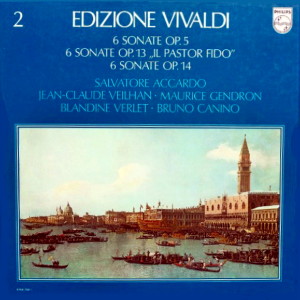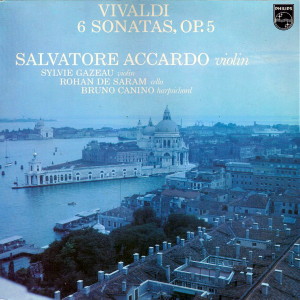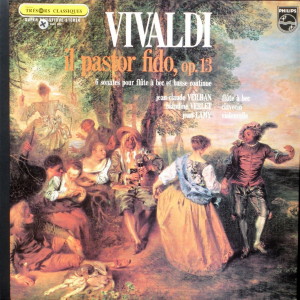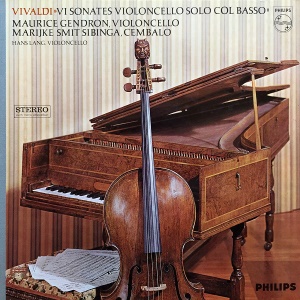 |
|
3 LP's
- 6768 750 - (c) 1978
|
 |
| 1 LP -
9500 396 - (p) 1977 |
 |
| 1 LP -
6504 009 - (p) 1970 |
 |
| 1 LP -
802 818 - (p) 1967 |
|
| EDIZIONE
VIVALDI - Vol. 2 |
|
|
|
|
|
|
|
| Antonio
Vivaldi (1678-1741) |
|
|
|
|
|
|
|
| Long Playing
1 |
|
56' 40" |
|
| 6 Sonaten op. 5 |
|
|
|
-
Nr. 1 F-dur, RV 18
- für Violine und Continuo
|
9'
49"
|
|
|
| -
Nr. 2 A-dur, RV 30 - für Violine und Continuo |
7' 47" |
|
|
| -
Nr. 3 B-dur, RV 33 - für Violine und Continuo |
9' 46" |
|
|
|
|
|
|
| -
Nr. 4 h-moll, RV 35 - für Violine und Continuo |
10' 03" |
|
|
| -
Nr. 5 B-dur, RV 76 - für zwei Violinen und
Continuo |
9' 49" |
|
|
| -
Nr. 6 g-moll, RV 72 - für zwei Violinen und
Continuo |
9' 26" |
|
|
Long Playing
2
|
|
52' 00" |
|
| 6 Sonaten für
Blockflöte, mit Cembalo und
Violoncello op. 13 "Il Pastor
Fido" |
|
|
|
| -
Nr. 4 C-dur, RV
59 |
8' 15" |
|
|
| -
Nr. 6 g-moll, RV
58 |
7' 11" |
|
|
| -
Nr. 5 C-dur, RV 55 |
10' 30" |
|
|
|
|
|
|
| -
Nr. 2 C-dur, RV 56 |
7' 45" |
|
|
| -
Nr. 3 G-dur, RV 57 |
8' 45" |
|
|
| - Nr. 1 C-dur,
RV 54 |
9' 34" |
|
|
| Long Playing
3 |
|
57' 12" |
|
| 6
Sonaten für Violoncello
und Continuo op. 14 |
|
|
|
| -
Nr. 1 B-dur, RV 47 |
6' 50" |
|
|
| -
Nr. 2 F-dur, RV 41 |
10' 55" |
|
|
| -
Nr. 3
a-moll, RV 43 |
10' 10" |
|
|
|
|
|
|
| -
Nr. 4 B-dur,
RV 45 |
10' 12" |
|
|
| -
Nr. 5
e-moll, RV 40 |
9' 25" |
|
|
| -
Nr. 6
B-dur, RV 46 |
9' 40" |
|
|
|
|
|
|
| Sonaten op. 5 |
Sonaten op. 13
"Il Pastor Fido"
|
Sonaten op. 14 |
|
| Salvatore Accardo,
Violine |
Jean-Claude Veilhan, Blockflöte |
Maurice Gendron, Violoncello |
|
Sykvie Gazeau,
Violine (5 & 6)
|
Blandine Verlet, Cembalo
(Ruckers) |
Marijke Smit Sibinga, Cembalo |
|
| Bruno
Canino, Cembalo |
Jean Lamy, Violoncello |
Hans Lang, Violoncello
(Continuo)
|
|
| Rohan
de Saram, Violoncello |
|
|
|
|
|
|
|
Luogo
e data di registrazione |
|
Amsterdam
(Olanda) - aprile 1977 (op. 5)
Parigi (Francia) - giugno 1970
(op. 13)
Het Wapen Van Eindhoven (Olanda) -
gennaio 1967 (op. 14) |
|
|
Registrazione: live /
studio |
|
studio |
|
|
Producer / Engineer |
|
- |
|
|
Prima Edizione
originale LP |
|
Philips
- 9500 396 - (1 LP) - durata 54'
40" - (p) 1977 - Analogico - (op.
5)
Philips - 6504 009 - (1 LP) -
durata 52' 00" - (p) 1970 -
Analogico - (op. 13)
Philips - 802 818 - (1 LP) -
durata 57' 12" - (p) 1967 -
Analogico - (op. 14) |
|
|
Note |
|
-
|
|
|
|
|
|
|
SIX
SONATAS, OP. 5
In
1716-17 the Amsterdam
publisher Estienne Roger
brought out three
collections of
instrumental music by
Vivaldi, using the imprint
of his daughter and
heir-designate Jeanne.
These comprised a set of
six sonatas, Op. 5, and
two sets of concertos, one
(Op. 6) containing six and
the other (Op. 7) 12
works. The initiative for
their publication almost
certainly came from Roger,
for had the project
originated with the
composer, he would surely
have provided dedications
for them, as he had done
in Op. 3 and Op. 4 and was
to do again in Op. 8 and
Op. 9. The fact is that in
the wake of the enormous,
continent-wide success of
Vivaldi’s first two
collections of concertos
there was an insatiable
demand for his music which
Roger would naturally be
eager to satisfy.
Although Vivaldi’s
reputation had been
founded on instrumental
music, his field of
activity had suddenly
widened in the mid-1710's
to embrace both sacred
vocal music and opera. The
abrupt departure from the
Pietà (the
Venetian
orphanage-cum-conservatoire
where he held the
positions of violin master
and orchestral director)
of its choirmaster
Francesco Casparini meant
that from 1713 until
perhaps as late as
1717-18, when Vivaldi took
up residence in Mantua, he
was required to compose
music for the chapel (his
great oratorio "Juditha
triumphans"
dates from 1716).
Concurrently, he was kept
busy at the Sant’Angelo
opera house as impresario
and resident
composer-arranger. During
these years, therefore,
instrumental composition
must have been pushed
somewhat into the
background.
Op. 5 contains four
sonatas for violin and basso
(the catch-all term for
cello, keyboard continuo,
or both combined) followed
by two for a pair of
violins with basso
continuo (here
clearly keyboard continuo,
optionally reinforced by
cello). Mixed instrumental
specifications of this
kind are common in
seventeenth-century
collections, rarer in the
more commercially minded
eighteenth century. In
the contemporary
collection most comparable
in this respect with
Vivaldi’s Op. 5, a group
of eight “solo” sonatas
and six trio sonatas
brought out in Paris by
the Italian émigré Michele
Mascitti as his Op. 4
(1711), the second violin
part in the trios is,
significantly, ad libitum.
The proportion of solo to
trio sonatas in both
collections illustrates
the change in the relative
popularity of the two
settings that occurred
soon after 1700.
All six works in Vivaldi’s
Op. 5 are styled as
chamber sonatas; that is,
they comprise two or three
dance movements introduced
by a Preludio.
With one exception the
dances belong to the five
favoured types: Allemanda
(in moderate to quick
quadruple time), Corrente
(in quick triple time), Sarabanda
(in slightly quicker
triple time), Giga
(in quick compound time -
here, rather unusually,
9/8), and Gavotta
(in very quick duple
time). Slower tempos are
found in the preludes,
which have all but shed
their ancestral connexion
with the opening movement
of the church sonata and
possess a truly dance-like
lilt. The Air-Menuet (was
this title Vivaldi’s?)
closing the last sonata
attests to the huge vogue
for the minuet in the
early eighteenth century.
Vivaldi’s close
contemporary Francesco
Antonio Bonporti had one
hundred of them published
in Venice c. 1710, while
Telemann’s quaintly worded
“Sept fois sept et un
menuet” came out in
Hamburg in 1728. All the
movements in Op. 5 are
cast in binary form,
repeats being prescribed
for both sections. The
greater length of the
second section allows for
modulatory digressions and
sometimes a reprise of the
opening idea.
It is interesting to
compare the solo sonatas
in Op. 5 with their
predecessors of Op. 2
(1709), especially as
Roger designated Op. 5 the
“second part” (parte
seconda) of Op. 2 and
accordingly numbered the
works from 13 to 18.
Although the bass in the
earlier set is named for
harpsichord, its
liveliness and high level
of thematic interaction
with the violin brings the
works very close to the
idiom of the sonatas for
violin and cello (without
continuo) which flourished
in Italy
around the turn of the
century. In Op. 5 the bass
is generally less
ambitious, but one finds
traces of its earlier
manner in the Gavotta
of the second sonata and
the Allemanda of
the fourth. The shape of
things to come is revealed
in the Gavotta
of the third sonata,
however, here the bass
provides a mere strut for
the violin, often
following it in parallel
motion as if to emphasise
its dependence. The style
of the new sonatas is
airier, less intense.
Playfulness is suggested
by the sometimes almost
inane repetition for bars
on end of simple figures.
The trios make an even
greater contrast with
their predecessors of Op.
1 (1705). The former
parity between the violins
is only occasionally
observed (most noticeably,
perhaps, in the Allemanda
of the last sonata); more
typical are passages where
the first violin holds
sway. The second violin
could even be omitted, a
la Mascitti, from the Preludio
of the same sonata without
serious damage. Vivaldi
does not disguise a strong
whiff of the concerto
style. In
several places one could
well imagine one is
hearing one of his chamber
concertos, several of
which are scored for a
trio combination. Looking
at the matter positively,
we might even say that in
these delightful sonatas
Vivaldi is, for the first
time in the sonata genre,
well and truly himself.
Michael
Talbot
SIX SONATAS, OP. 13 "IL
PASTOR FIDO"
We know very little about
the six sonatas for
bagpipe, lyre, flute,
oboe, or violin, and basso
continuo, which under the
title "Il
Pastor Fido" constitute
the Op. 13 of Antonio
Vivaldi. A copy of the
score is preserved in the
Arles Library and another
is to be found in the
Bavarian State Library in
Munich. A third is
reported to be in the
Arsenal Library in Paris.
This version, without
title or signature, is
integrated in a collection
of various pieces for
bagpipe.
The instrumentation of
these works and the fact
that "Il
Pastor Fido" was
published not in Italy but
in France (by Widow Boivin
in 1737) leads one to
think that they could be
arrangements of Vivaldi
compositions by a French
musician. In this
connexion there comes to
mind Chédeville
the Younger,
who showed particular
interest in the works of
Vivaldi.
In
1739 Chédeville
applied for a royal
licence "to adapt.
transpose, and arrange in
a simple manner suitable
for execution by bagpipe,
lyre, or flute" a
number of Italian works by
Vivaldi, including "The
Four Seasons". Finally
he indicated in his
dedication to the Marquis
de Collande
that he wished to adapt
the pieces to the "rustic
tone or the bagpipe" (M.
Pincherle). The bagpipe at
that time in France was
very much in fashion, but
in Italy
it was rarely plaved.
Finally, several movements
of "Il
Pastor Fido"
are taken from different
works by Vivaldi. For
example, the Allegro
assai of the second
sonata is borrowed from an
oboe concerto, the Allegro
ma non presto of the
fourth sonata is from a
violin concerto, and the
sixth sonata's Allegro
ma non presto is
from one of the concertos
of "La Stravaganza"
(similarly transcribed
by J.
S. Bach and arranged for
solo harpsichord). In view
of Vivaldi’s musical
fecundity, it seems odd
that he himself should
have rearranged his
earlier works for other
instruments instead of
writing new compositions.
One thing is sure; the
musical text of these
sonatas is by Vivaldi and
although we cannot prove
that the title "Il Pastor
Fido"
comes from the Venetian
master, it does,
nevertheless, suit this
music extraordinarily
well. Except for the
serious G
minor of the sixth sonata,
we find here a simple,
friendly, rustic form of
expression, which suits
perfectly the bucolic
character of the recorder,
the instrument we have
chosen for this reason
from those proposed in the
preface to the work.
Pains have been taken in
the performance to revive
the rules and usage of the
period (unequal
note values, articulation
pauses, grace notes, etc.)
and, as far as
ornamentation is
concerned, to find a
synthesis of the elegant
style of the French and
the inventiveness of the Italians.
The
Instruments
The recorder, the
harpsichord, and the cello
are all instruments of the
period. They are tuned to
the pitch customary in the
eighteenth century, a
half-tone lower than
normal today. Although the
sound is less brilliant,
it gains in warmth and
timbre.
The recorder, kindly lent
by Mme G.
Thibault-Chambure, of the
Conservatory of the
Instrument Museum, Paris,
is by Christian Schlegel
(Basel, early eighteenth
century). Its unequal
temperament gives it a
very individual sound.
The harpsichord, in which
all the elements are still
authentic, is a large
Ruckers of 1627,
“overhauled” in 1753 and
now the property of C.
Mercier-Ythier. (The
”overhaul” of a
harpsichord was a special
operation common in the
eighteenth century whereby
the sound spectrum of the
keyboard - particularly in
the lower octaves - was
enlarged. This
necessitated enlargement
of the case and changes in
the interior of the
instrument. In
the “overhaul” of this
Ruckers at that period a
lute stop was added to the
upper 8’.)
The maker of the cello was
Jacques
Boquay, who signed this
instrument in 1719. At
that period in France the
cello was beginning to
supplant the bass viol or
viola da gamba, which in
Italy had already
practically disappeared.
The writing of the bass
part and the indication
”violoncello” in the score
of “ll Pastor Fido” leave
no doubt about its use for
the continuo of this work.
This is further confirmed
by the concertante role of
the cello with the
recorder in the Pastorale
of the fourth sonata.
The organ, originally
intended for the Pastorale
of the fourth sonata, is a
positive instrument
constructed by D. Guiraud
and J.
Leguy on the model of
Italian instruments of the
eighteenth century. The
register used here is the
eight-foot bourdon.
J.C. Veilhan
Translation:
David Laird
SIX
SONATAS, OP. 14
About 1740 a publication
appeared bearing the title
“VI Sonates Violoncelle
Solo col Basso da
d'Antonio Vivaldi Musico
di Violino e Musico
de’Concerti del Pio
Ospidale [sic]
della Pietà
di Venezia gravé
par Mlle Michelon, Paris”.
There was no opus number
to the music. Around the
same time several
publishers in Paris
applied for licences to
publish an Op.14 by
Antonio Vivaldi, and in
December 1740 an
announcement appeared in
the “Mercure de France” to
the effect that six
sonatas for cello solo by
Vivaldi had been
published. It is therefore
assumed that the six
sonatas are Vivaldi's Op.
14. Although they were
published in Paris, they
were perhaps written for a
gifted cellist in
Vivaldi’s orchestra at the
Seminario musicale
dell’Ospedale della Pietà.
The primary function of a
viola da gamba or cello
player in the seventeenth
century and the early
eighteenth century was
that of playing the bass
line of all kinds of
music, which was doubled
by the left hand of the
harpsichord player, who
filled in chords over the
bass. In
this way the two players
accompanied solo
instruments, groups of
instruments, and provided
a support for all
orchestral and vocal
music. This unit of
harpsichord and bass
string instrument was the
”basso continuo.”
The cello was first used
to strengthen the bass
part, particularly in the
accompanying of vocal
music, and in orchestral
music, where the powerful
violins drowned the tone
of the gambas. However, in
Italy (where the violin
had been in common use
since the first half of
the seventeenth century,
and for which solo sonatas
were being written in the
second half of the
century) it was found that
the reedy quality of the
gamba provided
insufficient support in
continuo accompaniment,
and that the more powerful
cello balanced better with
the violin. The cello was,
in any case, a member of
the same family of
instruments as the violin,
whereas the viola da gamba
belonged to the older viol
family.
The emergence of the cello
as a solo instrument and
the appearance
of a solo literature for
the instrument was due to
cello virtuosos such as
Franceschini, Gabrielli,
Bononcini, and the famous
Caldara of Venice, who
made composers aware of
the potentials of this new
and powerful instrument.
While the basso continuo
parts of a great deal of
Corelli’s music are
probably for gamba, he is
said to have used the
cello in solo work, for
example in the concertino
section of his concerti
grossi. By Vivaldi’s time
the cello in Italy
had more or less replaced
the gamba in all fields,
and in his concertos he
writes some important solo
passages for it, e.g. in
the Concerto Op. 3 No. 11
the concertino cello takes
just as large a part as
the two concertino violins
in the rapid figurations
and scale passages.
Vivaldi”s interest in the
instrument led him to
write 27 concertos for
solo cello.
These sonatas fall into
the sonata da chiesa
(church sonata) category,
all consisting of four
movements which are
alternately slow and fast.
The sonata da chiesa
and sonata da camera
are usually
distinguishable by the
fact that in the latter
the dance movements are
named as such. Vivaldi,
however, did not make much
distinction between the
two types. Significantly,
the two fast movements of
the sixth sonata have
dance titles - after the Preludio
comes an Allemande,
and after the Largo,
a Corrente. All
other sonatas have fast
movements of similar
character to those of the
sixth sonata, which could
therefore equally well
bear the same titles;
further, the third
movement of the fifth
sonata could be called a Siciliano
rather than simply Largo.
The slow movements in
general exploit the
lyrical sustained sound of
the cello, while the
faster movements
demonstrate its agility
and powers of
articulation. The total
range of the sonatas is
small, the highest note
being A, an octave above
the A string, while the
lowest notes of the
instruments are only
touched upon and are not
tonally exploited in any
way. In
the faster movements
Vivaldi requires the
player to make rapid
string crossings in
executing wide-ranging
leaps -
for example in the second
movements of all the
sonatas and in particular
in that of the third
sonata in A minor.
Although there are several
performing editions of Op.
14 available at present,
the performers on this
recording preferred to use
an eighteenth-century
manuscript of the sonatas.
An edited edition of a
Baroque sonata does not
simply give the editor’s
suggestions about the
performances, but always
includes a realisation of
the bass line for the
keyboard i.e. all the
notes necessary for the
performance of the piece
are present. This has
arisen solely because the
practice of realising the
accompaniment from a bass
line fell into disuse
towards the end of the
eighteenth century. Since
the present revival of
Baroque music, keyboard
players have begun to
practise the art again.
To realise an
eighteenth-century bass
line in the twentieth
century not only requires
a thorough grounding in
keyboard harmony; it also
requires a deep sympathy
with the style of the
Baroque era and a vast
knowledge of the music of
that time in order to make
the turns of phrase and
ornamental figurations
sound authentic. In
the realisation of a
figured bass keyboard
players and editors have
two alternatives. They can
either realise the bass
line in such a way - as in
Luigi Dallapiccola’s
edition of Vivaldi’s
cello sonatas - that a
modern version is made of
an eighteenth-century
piece or, as in this
recording, they can
perform the basso continuo
as authentically as
possible by using a
thorough knowledge of
Baroque musical practice.
|
|

